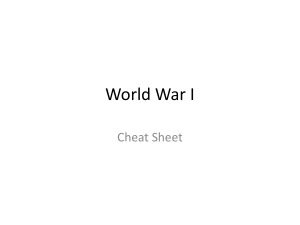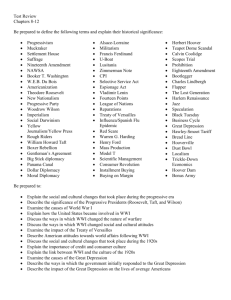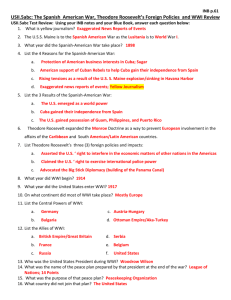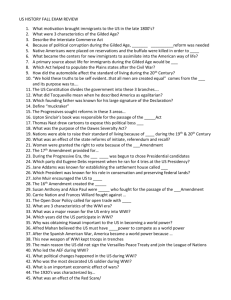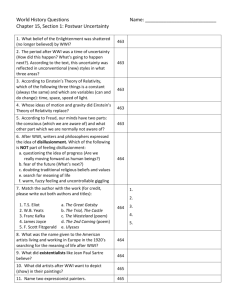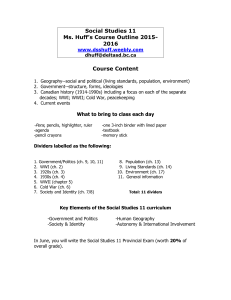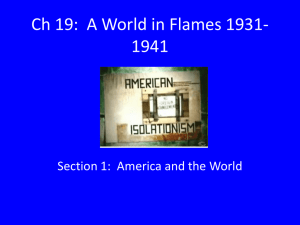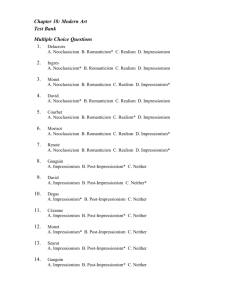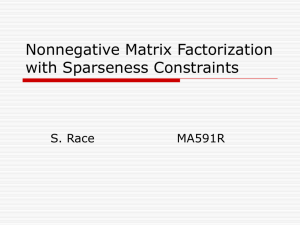The Twentieth Century - Northern State University
advertisement
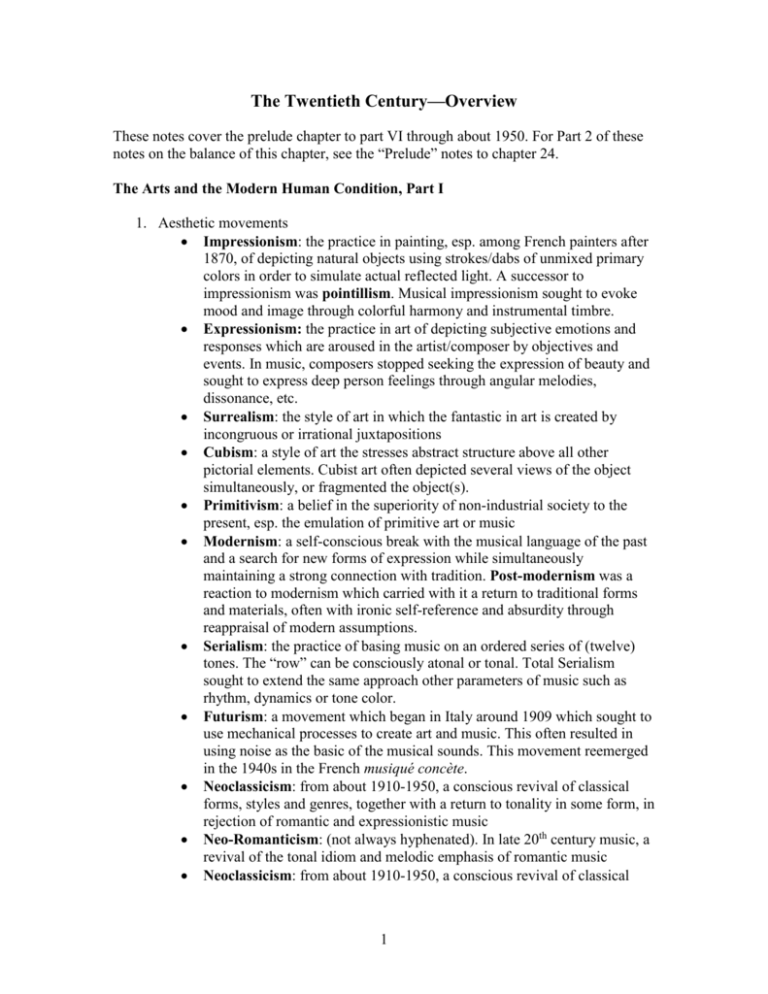
The Twentieth Century—Overview These notes cover the prelude chapter to part VI through about 1950. For Part 2 of these notes on the balance of this chapter, see the “Prelude” notes to chapter 24. The Arts and the Modern Human Condition, Part I 1. Aesthetic movements Impressionism: the practice in painting, esp. among French painters after 1870, of depicting natural objects using strokes/dabs of unmixed primary colors in order to simulate actual reflected light. A successor to impressionism was pointillism. Musical impressionism sought to evoke mood and image through colorful harmony and instrumental timbre. Expressionism: the practice in art of depicting subjective emotions and responses which are aroused in the artist/composer by objectives and events. In music, composers stopped seeking the expression of beauty and sought to express deep person feelings through angular melodies, dissonance, etc. Surrealism: the style of art in which the fantastic in art is created by incongruous or irrational juxtapositions Cubism: a style of art the stresses abstract structure above all other pictorial elements. Cubist art often depicted several views of the object simultaneously, or fragmented the object(s). Primitivism: a belief in the superiority of non-industrial society to the present, esp. the emulation of primitive art or music Modernism: a self-conscious break with the musical language of the past and a search for new forms of expression while simultaneously maintaining a strong connection with tradition. Post-modernism was a reaction to modernism which carried with it a return to traditional forms and materials, often with ironic self-reference and absurdity through reappraisal of modern assumptions. Serialism: the practice of basing music on an ordered series of (twelve) tones. The “row” can be consciously atonal or tonal. Total Serialism sought to extend the same approach other parameters of music such as rhythm, dynamics or tone color. Futurism: a movement which began in Italy around 1909 which sought to use mechanical processes to create art and music. This often resulted in using noise as the basic of the musical sounds. This movement reemerged in the 1940s in the French musiqué concète. Neoclassicism: from about 1910-1950, a conscious revival of classical forms, styles and genres, together with a return to tonality in some form, in rejection of romantic and expressionistic music Neo-Romanticism: (not always hyphenated). In late 20th century music, a revival of the tonal idiom and melodic emphasis of romantic music Neoclassicism: from about 1910-1950, a conscious revival of classical 1 Minimalism: a style and/or technique in late 20th century characterized by sparseness and simplicity, often with extreme repetition. Postminimalism moved away extreme sparseness while still using repetition and the music became more intricate and/or melodic. 2. New views of the human mind and the physical world Psychoanalytical: around 1900, the Viennese-Jewish doctor Sigmund Freud developed theories of human behavior based on subconscious mind. Freud believed that human behavior resulted from unconscious desires which were repressed by cultural restraints and taboos. He believed that dreams were projections of those unconscious thoughts and desires. Scientific: almost simultaneously, Ivan Pavlov was awarded the Nobel Prize in 1904 for his research into the digestive system. Pavlov was a physiologist and psychologist. His research was in the area of classical conditioning, which led to behavioral psychology. Einstein proposed the General Theory of Relativity in 1916, revolutionizing the view of the physical world and paving the way for the atomic bomb 3. Movements in the Arts—supported by Romantic ideas of the Artist as an “enlightened visionary”, new directions in literature and painting emerged, such as: Symbolist poets—Paul Verlaine, Stéphane Mallarmé, Paul Valéry, and Stefan George Impressionist painters—Monet, Ceézanne Cubist painters—Pablo Picasso, Georges Braque Surrealism—René Magrite, Salvador Dali, Expressionism—Edvard Munch Disillusionment—T.S. Elliot, Marcel Proust, James Joyce Political Fiction and Art—Bertold Brecht, Virginia Woolf, John Steinbeck, Diego Rivera, Thomas Hart Benson, 4. Technological Revolution Rise of Mass Production, especially of the automobile Electric lighting Advances in flight for both civilian and military purposes Recording and mass media with the radio and later, television led to the formation of the sponsorship of orchestras by broadcast companies, e.g., the BBC Symphony Orchestra in London and the NBC Symphony in New York. 5. New opportunities and forms of patronage—in addition to broadcast companies sponsoring the arts, universities, colleges and conservatories emerged as centers. Also, the movie industry emerged as a major employer of composers, artists, actors and writers. 2 6. Modern Times A. The 20th century was self-consciously modern, with a combination of confidence in “progress” and the new age, and nostalgia for the past. B. Political history from the turn of the century until approximately the end of World War II was marked by: Pre-WWI migration to urban centers Formation of various alliances at the end of the 19th century A second wave of immigration to the United States. Social unrest and reform through revolutions, strikes and labor unions Competition for dominance among the colonial powers of Britain, France, and the German, Austro-Hungarian, Russian and Ottoman empires. The division of political alliances into the Allied (Entente) powers of France, British Empire, Italy, and (later) the United States, opposed by the Central Powers of Germany, Austria-Hungary, the Ottoman Empire and Bulgaria. These were called the Central Powers because they were located between France and Russia. Outbreak of WWI (1914-1918). Rise of the United States as a major power, a transformation which was completed through the outcomes of WWI. Russian Revolution (1917) Formation of the League of Nations which was, ultimately, unable to deal with the social and political forces in the wake of WWI. The Great Depression Rise of new ideologies in the wake of WWI, including Fascism, Nazism, and Communism Spanish Civil War (1936-39) World War II, in part fought as a continuation of WWI because of issues which were inequitably solved or left unresolved from WWI The Holocaust (also known as Ha-Shoah or השואהin Hebrew) in which about 6,000,000 European Jews and another 5,000,000 Catholics, Gypsies, mentally handicapped, homosexuals, prisoners of war (especially Russians), etc. Approximately 2/3s of the pre-war European population of Jews was killed. Ha-Shoah means “the catastrophe”. Use of firebombing against Germany and nuclear weapons against Japan plus the direct casualties of war made WWII the most destructive war the world had seen. Formation of the United Nations Beginning of the Cold War, in which the Communist Block, formed by the Soviet Union which installed governments in Poland, Czechoslovakia, and Hungary. Additional communist governments formed in Yugoslavia, Albania, and China. 3
